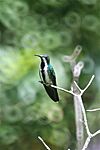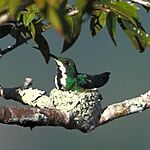Black-throated mango facts for kids
Quick facts for kids Black-throated mango |
|
|---|---|
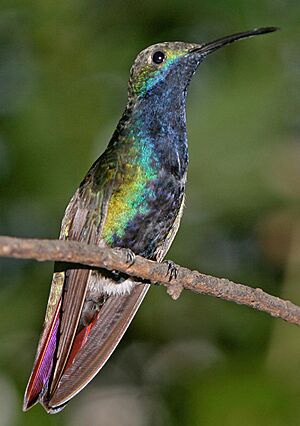 |
|
| Male at Puerto Iguazú, Misiones Province, Argentina | |
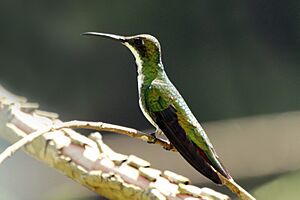 |
|
| Female in Tobago | |
| Conservation status | |
| Scientific classification | |
| Genus: |
Anthracothorax
|
| Species: |
nigricollis
|
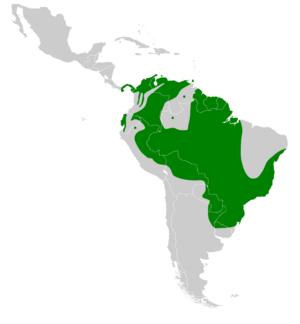 |
|
The black-throated mango (Anthracothorax nigricollis) is a beautiful type of hummingbird. It belongs to the Trochilidae family. You can find this bird in Panama and most countries in South America. It also lives on the islands of Trinidad and Tobago.
Contents
About the Black-throated Mango
Hummingbirds are amazing birds, and the black-throated mango is one of them! Scientists group animals into different families and types. This hummingbird is part of the Anthracothorax group.
Scientists have found two main types, or subspecies, of the black-throated mango. They are called A. n. nigricollis and A. n. iridescens.
What Does the Black-throated Mango Look Like?
This hummingbird is about 10 to 14 centimeters (4 to 5.5 inches) long. It weighs between 6 and 9 grams (about 0.2 to 0.3 ounces). Both male and female birds have a slightly curved black beak.
Male Black-throated Mangoes
Adult males have shiny bronze-green feathers on their head, neck, and back. Their inner tail feathers are dusky bronze-green. The outer tail feathers are a bright metallic magenta-red with dark blue edges. Their wings are grayish-brown.
Males have a black chin, throat, and chest. The sides of their chest and belly are a metallic bluish-green. Their sides and flanks are bronzy-green.
Female Black-throated Mangoes
Female black-throated mangoes have metallic green feathers on their head, neck, and back. This green is not as bronzy as the males'. Their inner tail feathers are dusky bronze-green.
The outer tail feathers are rufous (reddish-brown) with a wide purple base. They also have whitish tips. Females have a thin, black stripe on their chin and throat, bordered by white. The rest of their belly is green.
Young Black-throated Mangoes
Young birds look a bit like adult females. They have a white chin, throat, and chest with a thin black line down the middle. Some brown feathers on their head and back make them look a bit striped. Their lower back and rump feathers have dull cinnamon-buff tips.
Young females might have some rusty or buff colors on their white belly. Their undertail feathers are green, and the underside of their tail is mostly dull carmine (red).
Where Do They Live?
The main type of black-throated mango (A. n. nigricollis) lives in many places. You can find it from western Panama down through much of Colombia and Venezuela. It also lives in the Guianas, eastern Ecuador and Peru, and parts of Bolivia, Paraguay, and Argentina. Most of Brazil and the islands of Trinidad and Tobago are also home to this bird. Sometimes, it even visits Uruguay.
The other type (A. n. iridescens) lives in a smaller area. It is found in southwestern Colombia, western Ecuador, and northwestern Peru.
Black-throated Mango Habitats
These hummingbirds live in many different open or semi-open places in warm, lowland areas. They like gallery forests, coffee and cacao farms, and the edges of thick forests. You can also spot them in parks and gardens in towns and cities.
They usually live in lowlands. However, they can be found up to 1,400 meters (4,600 feet) high in Venezuela. In Colombia, they reach 1,700 meters (5,600 feet), and in eastern Brazil, they can be found up to 2,000 meters (6,600 feet) high.
How Do They Behave?
Movement and Migration
Black-throated mangoes usually stay in one place. But some groups might move around during certain seasons. They might also move to find more flowering plants for food. Birds in eastern Brazil are thought to travel long distances. Scientists are still learning more about these movements.
What Do They Eat?
These hummingbirds mainly eat nectar from flowers. They especially like the flowers of tall trees. Some of their favorite trees include Erythrina, Eucalyptus, Mabea, Spirotheca, Tabebuia, and Spathodea. They also get nectar from many kinds of vines and shrubs.
Male hummingbirds often protect their feeding areas in trees. However, they are not as aggressive as some other hummingbirds. Besides nectar, they also eat insects. They often catch insects by flying out from a high perch. Sometimes, they pick insects off leaves, but this is less common.
How Do They Raise Their Young?
The breeding season for the black-throated mango varies depending on where they live. In Trinidad, they nest from December to July. In coastal Venezuela, it's between January and April. In parts of Brazil, it can be from November to February or in July and August. They might even nest all year in Colombia.
The female hummingbird builds a cup-shaped nest. She uses soft plant materials like seed fluff and small roots. She decorates the outside with lichen and holds it all together with spider silk. Nests are often placed in open spots, like on bare tree branches or even on power lines.
The female lays two eggs. She sits on the eggs for 16 to 18 days until they hatch. The young birds leave the nest 20 to 26 days after hatching. They become fully independent about two weeks after that. Only the female bird incubates the eggs and feeds the baby birds.
One black-throated mango nest was found in a tree with stinging ants. It's possible that the ants help protect the nest from predators. However, scientists don't know if the birds choose these trees on purpose.
What Sounds Do They Make?
The black-throated mango is not a very noisy bird. Males sing from trees, making a sound like "hsl-hsl-hsl-hsl-hsl-hsl-hsl". Their calls include sounds like "twick" or "tiuck" and a "tsick".
Gallery
-
Female on nest at Novo Mundo, Mato Grosso State, Brazil




